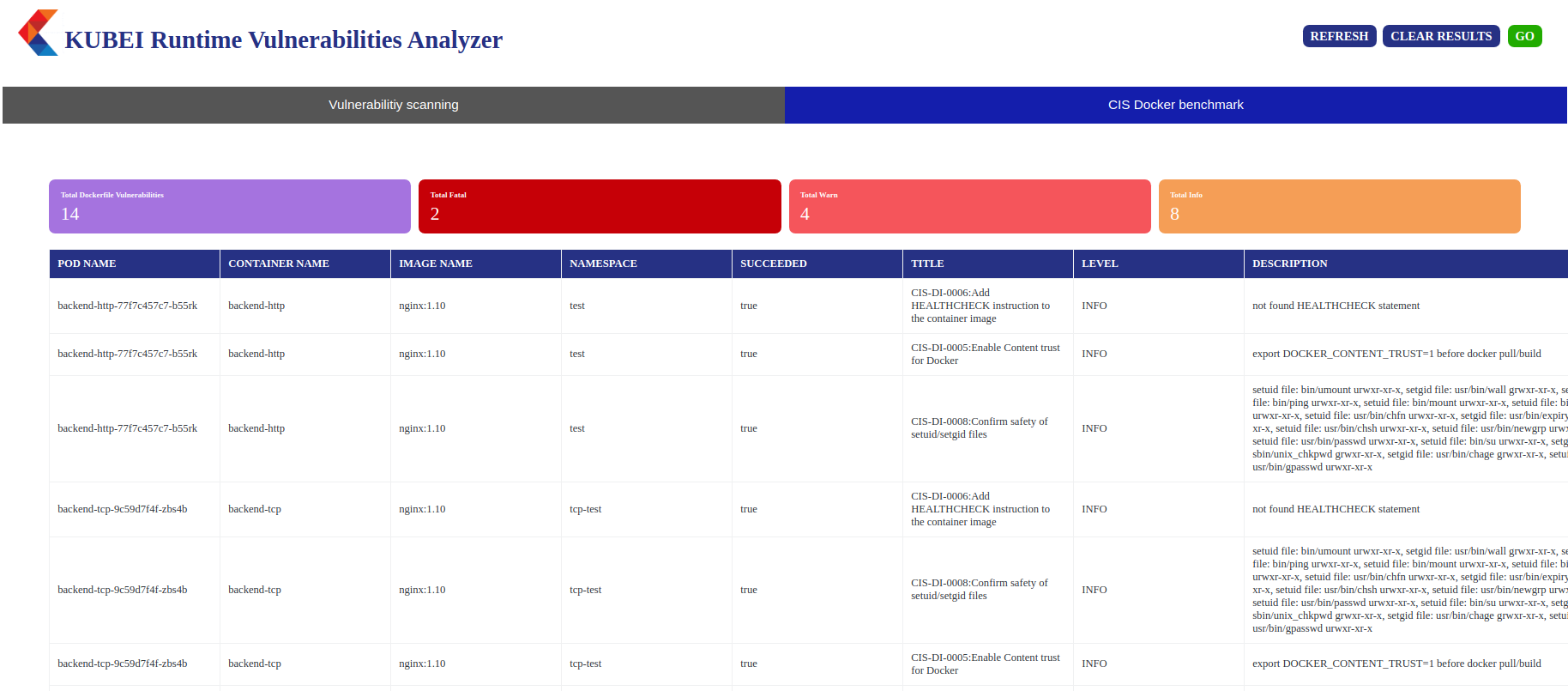Kubei is a vulnerabilities scanning and CIS Docker benchmark tool that allows users to get an accurate and immediate risk assessment of their kubernetes clusters. Kubei scans all images that are being used in a Kubernetes cluster, including images of application pods and system pods. It doesn’t scan the entire image registries and doesn’t require preliminary integration with CI/CD pipelines.
It is a configurable tool which allows users to define the scope of the scan (target namespaces), the speed, and the vulnerabilities level of interest.
It provides a graphical UI which allows the viewer to identify where and what should be replaced, in order to mitigate the discovered vulnerabilities.
- A Kubernetes cluster is ready, and kubeconfig (
~/.kube/config) is properly configured for the target cluster.
- Read secrets in cluster scope. This is required for getting image pull secrets for scanning private image repositories.
- List pods in cluster scope. This is required for calculating the target pods that need to be scanned.
- Create jobs in cluster scope. This is required for creating the jobs that will scan the target pods in their namespaces.
The file deploy/kubei.yaml is used to deploy and configure Kubei on your cluster.
-
Set the scan scope. Set the
IGNORE_NAMESPACESenv variable to ignore specific namespaces. SetTARGET_NAMESPACEto scan a specific namespace, or leave empty to scan all namespaces. -
Set the scan speed. Expedite scanning by running parallel scanners. Set the
MAX_PARALLELISMenv variable for the maximum number of simultaneous scanners. -
Set severity level threshold. Vulnerabilities with severity level higher than or equal to
SEVERITY_THRESHOLDthreshold will be reported. Supported levels areUnknown,Negligible,Low,Medium,High,Critical,Defcon1. Default isMedium. -
Set the delete job policy. Set the
DELETE_JOB_POLICYenv variable to define whether or not to delete completed scanner jobs. Supported values are:All- All jobs will be deleted.Successful- Only successful jobs will be deleted (default).Never- Jobs will never be deleted.
-
Disable CIS Docker benchmark. Set the
SHOULD_SCAN_DOCKERFILEenv variable tofalse. -
Set the scanner service account. Set the
SCANNER_SERVICE_ACCOUNTenv variable to a service account name to be used by the scanner jobs. Defaults todefaultservice account. -
Scan insecure registries. Set the
REGISTRY_INSECUREenv variable to allow the scanner to access insecure registries (HTTP only). Default isfalse.
-
Run the following command to deploy Kubei on the cluster:
kubectl apply -f https://raw.githubusercontent.com/Portshift/kubei/master/deploy/kubei.yaml -
Run the following command to verify that Kubei is up and running:
kubectl -n kubei get pod -lapp=kubei -
Then, port forwarding into the Kubei webapp via the following command:
kubectl -n kubei port-forward $(kubectl -n kubei get pods -lapp=kubei -o jsonpath='{.items[0].metadata.name}') 8080 -
In your browser, navigate to http://localhost:8080/view/ , and then click 'GO' to run a scan.
-
To check the state of Kubei, and the progress of ongoing scans, run the following command:
kubectl -n kubei logs $(kubectl -n kubei get pods -lapp=kubei -o jsonpath='{.items[0].metadata.name}') -
Refresh the page (http://localhost:8080/view/) to update the results.
Uncomment and configure the proxy env variables for the Grype Server and Kubei deployments in deploy/kubei.yaml.
Create an AWS IAM user with AmazonEC2ContainerRegistryFullAccess permissions.
Use the user credentials (AWS_ACCESS_KEY_ID, AWS_SECRET_ACCESS_KEY, AWS_DEFAULT_REGION) to create the following secret:
cat <<EOF | kubectl apply -f -
apiVersion: v1
kind: Secret
metadata:
name: ecr-sa
namespace: kubei
type: Opaque
data:
AWS_ACCESS_KEY_ID: $(echo -n 'XXXX'| base64 -w0)
AWS_SECRET_ACCESS_KEY: $(echo -n 'XXXX'| base64 -w0)
AWS_DEFAULT_REGION: $(echo -n 'XXXX'| base64 -w0)
EOF
Note:
- Secret name must be
ecr-sa - Secret data keys must be set to
AWS_ACCESS_KEY_ID,AWS_SECRET_ACCESS_KEYandAWS_DEFAULT_REGION
Create a Google service account with Artifact Registry Reader permissions.
Use the service account json file to create the following secret
kubectl -n kubei create secret generic --from-file=sa.json gcr-sa
Note:
- Secret name must be
gcr-sa sa.jsonmust be the name of the service account json file when generating the secret- Kubei is using application default credentials. These only work when running Kubei from GCP.
-
Supports Kubernetes Image Manifest V 2, Schema 2 (https://docs.docker.com/registry/spec/manifest-v2-2/). It will fail to scan on earlier versions.
-
The CVE database will update once a day.



